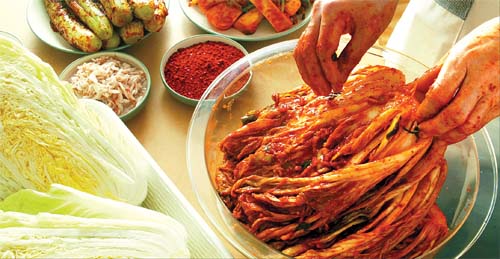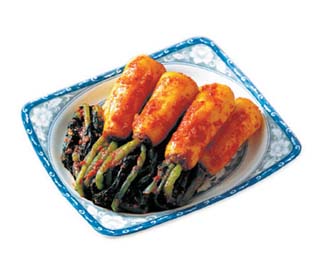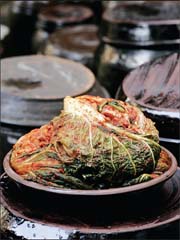In spices and vegetables, the essence of Korea

Pogikimchi (whole cabbage kimchi) 포기김치
The fact that kimchi (a fermented dish made of seasoned vegetables) is one of only five Korean words in the Oxford English dictionary is quite telling. The spicy side dish, most frequently made with cabbage, is one of the few cultural assets of this country that are well known outside of Korea.
*ferment: 발효(하다)
양념이 된 야채로 만들어진 발효 요리인 김치가 옥스퍼드 영영 사전에 실린 5개의 한국말 중 하나라는 사실은 의미가 깊다. 주로 배추로 만들어지는 매운 김치는 한국 바깥에도 잘 알려진 한국의 문화 유산의 하나이다.
There aren't many Koreans who can live without it, so much so that Pizza Hut in Korea, upon request, will serve kimchi as a side dish. Electronics companies sell special "kimchi refrigerators," which were developed to store kimchi at the ideal temperature for proper fermentation. Korea without kimchi would be like America without ketchup.
김치 없이 살 수 있는 한국인은 많지 않다. 한국 핏자헛에서도 고객의 요구에 맞춰 반찬으로 김치를 내놓을 정도다. 가전 회사들은 김치를 잘 익게 하기 위해 적정온도로 보관하는 김치 냉장고를 팔고 있다. 김치 없는 한국은 케첩 없는 미국과 비유할 수 있다.
Korea has been an agrarian society for most of its history, and its diet relied heavily on vegetables. Its cold winters made cultivation difficult for months on end and storage methods had to be developed to ensure an uninterrupted food supply.

chonggakkimchi (radish kimchi) /총각김치
*cultivation: 재배
한국의 역사적으로 농경 사회여서 식생활이 야채에 크게 의존해 왔다. 추운 겨울에는 수 개월 동안 야채 재배가 힘들기 때문에 계속해서 음식을 공급하기 위해서는 저장법이 개발돼야 했다.
Experts differ over the exact moment when kimchi was born but most trace its development to the agrarian culture before the Three Kingdoms era, in the 4th to 7th centuries. Early Chinese records, including "Samgukji" (Record of the Three Chinese Kingdoms) say "The people of Goguryu heritage have an aptitude for making fermented foods."
*heritage: 유산
*aptitude: 습성
전문가들 간에 김치가 정확히 언제 만들어졌는지 의견이 있지만 대부분 4세기에서 7세기 사이 삼국시대 이전의 농경문화에서 발전했을 것으로 본다. 초기 중국 문헌인 '삼국지'는 "고구려계 사람들은 발표 음식을 만들어 먹는 습관이 있었다"고 밝힌다.
Linguistics scholars say that the word kimchi probably originated from two Chinese characters, chim and chae, which, together, mean "salting vegetables." Over the years, this term underwent various changes, going from dimchae to kimchae and, then, to kimchi.

Baechukimchi(cabbage kimchi). [JoongAng Ilbo]/ 배추김치. 사진은 중앙일보 제공
언어학자들은 김치란 말이 아마 절인 야채를 뜻하는 중국 문자인 침과 채에서 왔을 것으로 추정한다. 세월이 흐르며 이 말은 딤채에서 김채로 나중에 김치로 변했다는 것이다.
The earliest form of kimchi was a bit different from today's product. "Before red peppers came into Korea after the Japanese invasion in 1592, kimchi was basically a salted vegetable, the salting process being solely for the purpose of preserving the vegetables," said Shin Hae-won, the chief curator at the Kimchi Museum in southern Seoul.
*curator: 전시 기획자
김치의 초기 형태는 오늘날과 다소 달랐다. "1592년 일본 침략으로 고추가 한국에 들어오기 전까지 김치는 기본적으로 절인 야채였으며, 절이는 과정은 야채를 보전하기 위한 목적이었다"고 서울 남부의 김치 박물관 전시기획자인 신해원씨는 말했다.
During the Goryeo Dynasty, Korean cuisine was still dependent upon vegetables. This era saw many kinds of vegetables begin to appear, including radishes, eggplants, cucumbers, Korean leeks, dropwort, mallows and fernbrakes, among others, all of which were used as main ingredients for kimchi.
*radish: 무
*eggplant: 가지
고려 시대에도 한국의 요리는 야채에 의존했다. 이 시기에 무, 가지, 오이, 부추, 미나리, 아욱, 고사리 등 많은 종류의 야채들이 나타났으며, 이것들이 김치의 주 재료로 사용됐다.
Pogikimchi (whole cabbage kimchi), , and baekkimchi (cabbage kimchi without red pepper),
포기김치와 총각김치, 백김치










with the Korea JoongAng Daily
To write comments, please log in to one of the accounts.
Standards Board Policy (0/250자)